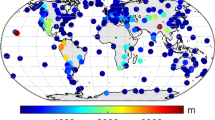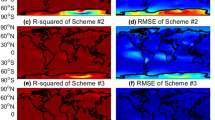Abstract
Global pressure and temperature (GPT) models are widely available and easy-to-use in tropospheric delay estimation and GNSS water vapor retrieval, but cannot capture the diurnal and semidiurnal variations that add uncertainty to tropospheric delay determinations. This paper introduces an improved global pressure and temperature model (IGPT) established using 10 years hourly ERA5 dataset provided by the European Centre for Medium-Range Weather Forecasts. This IGPT model effectively captures the diurnal and semidiurnal patterns as well as their seasonal variations in global pressure and temperature signals. The IGPT model also assimilates the radiosonde data to improve height correction, which extends the feasibility of the model from the earth surface to up to 15 km. The performance of the IGPT model was evaluated with four types of datasets: a 3-year ERA5 hourly dataset, a decade of radiosonde surface data, 1-year radiosonde upper-air data, and 1-year global navigation satellite system (GNSS) zenith troposphere delay (ZTD) products. By considering the intraday variations, the average RMS of pressure and temperature errors on the surface in IGPT were about 5.97 hPa and 3.68 K, with improvements of 1.8% and 22.4% as compared with the GPT3 model. By assimilating the radiosonde data, the accuracy of IGPT pressure and temperature at high altitude was 7.47 hPa and 7.22 K, achieving an improvement of 72.1% and 51.1%, respectively, relative to the GPT3 model. The IGPT model also slightly improved the computational accuracy of the GNSS ZTD as compared to calculations using the GPT3 model. The coefficients and the MATLAB source code of the IGPT model are available online (https://zenodo.org/record/3893412).














Similar content being viewed by others
References
Andrei C-O, Chen R (2009) Assessment of time-series of troposphere zenith delays derived from the Global Data Assimilation System numerical weather model. GPS Solut 13:109–117. https://doi.org/10.1007/s10291-008-0104-1
Askne J, Nordius H (1987) Estimation of tropospheric delay for microwaves from surface weather data. Radio Sci 22:379–386. https://doi.org/10.1029/RS022i003p00379
Balidakis K, Nilsson T, Zus F, Glaser S, Heinkelmann R, Deng Z, Schuh H (2018) Estimating integrated water vapor trends from VLBI, GPS, and numerical weather models: sensitivity to tropospheric parameterization. J Geophys Res Atmos 123:6356–6372. https://doi.org/10.1029/2017jd028049
Berg H (1948) Allgemeine Meteorologie: Einführung in die Physik der Atmosphäre, vol 4. Dümmlers Verlag, Bonn
Boehm J, Heinkelmann R, Schuh H (2007) Short note: A global model of pressure and temperature for geodetic applications. J Geodesy 81:679–683. https://doi.org/10.1007/s00190-007-0135-3
Böhm J, Möller G, Schindelegger M, Pain G, Weber R (2014) Development of an improved empirical model for slant delays in the troposphere (GPT2w). GPS Solut 19:433–441. https://doi.org/10.1007/s10291-014-0403-7
Compo GP et al (2011) The twentieth century reanalysis project. Q J R Meteorol Soc 137:1–28. https://doi.org/10.1002/qj.776
Covey C, Dai A, Lindzen R, Marsh D (2014) Atmospheric tides in the latest generation of climate models. J Atmos Sci 71:1905–1913. https://doi.org/10.1175/JAS-D-13-0358.1
Dai A, Trenberth KE (2004) The diurnal cycle and its depiction in the community climate system model. J Clim 17:930–951
Dai A, Wang JH (1999) Diurnal and semidiurnal tides in global surface pressure fields. J Atmos Sci 56:3874–3891. https://doi.org/10.1175/1520-0469(1999)056%3c3874:Dastig%3e2.0.Co;2
Dee DP et al (2011) The ERA-Interim reanalysis: configuration and performance of the data assimilation system. Q J R Meteorol Soc 137:553–597. https://doi.org/10.1002/qj.828
Dow JM, Neilan RE, Rizos C (2009) The International GNSS Service in a changing landscape of Global Navigation Satellite Systems. J Geodesy 83:191–198. https://doi.org/10.1007/s00190-008-0300-3
Drożdżewski M, Sośnica K, Zus F, Balidakis K (2019) Troposphere delay modeling with horizontal gradients for satellite laser ranging. J Geodesy 93:1853–1866. https://doi.org/10.1007/s00190-019-01287-1
Haurwitz B, Cowley AD (1973) The diurnal and semidiurnal barometric oscillations global distribution and annual variation. Pure Appl Geophys 102:193–222. https://doi.org/10.1007/bf00876607
Hopfield HS (1969) Two-quartic tropospheric refractivity profile for correcting satellite data. J Geophys Res 74:4487–4499
Hopfield HS (1971) Tropospheric effect on electromagnetically measured range: prediction from surface weather data. Radio Sci 6:357–367
Hulley GC, Pavlis EC (2007) A ray-tracing technique for improving Satellite Laser Ranging atmospheric delay corrections, including the effects of horizontal refractivity gradients. J Geophys Res Solid Earth 112:19. https://doi.org/10.1029/2006jb004834
Jin S, Luo OF, Gleason S (2009) Characterization of diurnal cycles in ZTD from a decade of global GPS observations. J Geodesy 83:537–545. https://doi.org/10.1007/s00190-008-0264-3
Kouba J (2009) Testing of global pressure/temperature (GPT) model and global mapping function (GMF) in GPS analyses. J Geodesy 83(3–4):199–208
Lagler K, Schindelegger M, Bohm J, Krasna H, Nilsson T (2013) GPT2: empirical slant delay model for radio space geodetic techniques. Geophys Res Lett 40:1069–1073. https://doi.org/10.1002/grl.50288
Landskron D, Bohm J (2018) VMF3/GPT3: refined discrete and empirical troposphere mapping functions. J Geodesy 92:349–360. https://doi.org/10.1007/s00190-017-1066-2
Leandro R, Santos M, Langley RB, Institute of N (2006) UNB neutral atmosphere models: development and performance. In: 2006 National technical meeting of the institute of navigation, Monterey, CA
Leandro RF, Langley RB, Santos MC (2008) UNB3m_pack: a neutral atmosphere delay package for radiometric space techniques. GPS Solut 12:65–70. https://doi.org/10.1007/s10291-007-0077-5
Legeais J-F, Michaël A, Thao S (2014) Evaluation of wet troposphere path delays from atmospheric reanalyses and radiometers and their impact on the altimeter sea level. Ocean Sci 10:893–905. https://doi.org/10.5194/os-10-893-2014
Li T, Wang L, Chen R, Xu B, Zhang X (2019) Accuracy analysis of GPT2/GPT2w models for SLR-based satellite orbits validation. In: 10th China satellite navigation conference, Beijing, China. Springer, Singapore
Mateus P, Catalão J, Mendes VB, Nico G (2020) An ERA5-based hourly global pressure and temperature (HGPT) model. Remote Sens 12:1098
Mendes VB, Pavlis EC (2004) High-accuracy zenith delay prediction at optical wavelengths. Geophys Res Lett. https://doi.org/10.1029/2004GL020308
Pavlis NK, Holmes SA, Kenyon SC, Factor JK (2013) Correction to “The development and evaluation of the earth gravitational model 2008 (EGM2008).” J Geophys Res Solid Earth 118:2633–2633. https://doi.org/10.1002/jgrb.50167
Penna N, Dodson A, Chen W (2001) Assessment of EGNOS tropospheric correction model. J Nav 54:37–55. https://doi.org/10.1017/S0373463300001107
Saastamoinen J (1972) Atmospheric correction for the troposphere and stratosphere in radio ranging satellites. In: Henriksen SW, Mancini A, Chovitz BH (eds) The Use of Artificial Satellites for Geodesy. Wiley, New York, pp 247–251. https://doi.org/10.1029/GM015p0247
Schindelegger M, Ray RD (2014) Surface pressure tide climatologies deduced from a quality-controlled network of barometric observations. Mon Weather Rev 142:4872–4889. https://doi.org/10.1175/MWR-D-14-00217.1
Schüler T (2014) The TropGrid2 standard tropospheric correction model. GPS Solut 18:123–131. https://doi.org/10.1007/s10291-013-0316-x
Schueler T, Hein GW, Eissfeller B (2001) A new tropospheric correction model for GNSS navigation. In: Proceedings of GNSS 2001, 5th international symposium on global navigation satellite systems, Instituto de Navigacion de Espana, Sevilla, Spain, 8–11 May
Wang X, Zhang K, Wu S, Fan S, Cheng Y (2016) Water-vapor-weighted mean temperature and its impact on the determination of precipitable water vapor and its linear trend. J Geophys Res Atmos 121:833–852
Wang X, Zhang K, Wu S, He C, Cheng Y, Li X (2017) Determination of zenith hydrostatic delay and its impact on GNSS-derived integrated water vapor. Atmos Meas Techn 10:2807–2820. https://doi.org/10.5194/amt-10-2807-2017
Wilgan K, Rohm W, Bosy J (2015) Multi-observation meteorological and GNSS data comparison with numerical weather prediction model. Atmos Res 156:29–42
Xu C, Yao Y, Shi J, Zhang Q, Peng W (2020) Development of global tropospheric empirical correction model with high temporal resolution. Remote Sens 12:721
Yang F, Guo J, Meng X, Shi J, Xu Y, Zhang D (2019) Determination of weighted mean temperature (Tm) lapse rate and assessment of its impact on Tm calculation. IEEE Access 7:1–1. https://doi.org/10.1109/ACCESS.2019.2946916
Yang F, Meng X, Guo J, Shi J, An X, He Q, Zhou L (2020) The influence of different modelling factors on global temperature and pressure models and their performance in different zenith hydrostatic delay (ZHD) models. Remote Sens 12:35
Yao Y, Xu C, Shi J, Cao N, Zhang B, Yang J (2015) ITG: a new global GNSS tropospheric correction model. Sci Rep 5:10273. https://doi.org/10.1038/srep10273
Yao YB, Sun ZY, Xu CQ, Zhang L, Wan YY (2018) Development and assessment of the atmospheric pressure vertical correction model with ERA-interim and radiosonde data. Earth Space Sci 5:777–789. https://doi.org/10.1029/2018ea000448
Zhang W, Lou Y, Huang J, Liu W (2018) A refined regional empirical pressure and temperature model over China. Adv Space Res 62:1065–1074. https://doi.org/10.1016/j.asr.2018.06.021
Acknowledgements
We are grateful to the European Centre for Medium-Range Weather Forecasts for providing ERA5 reanalysis data (https://cds.climate.copernicus.eu/#!/search?text=ERA5&type=dataset), the Integrated Global Radiosonde Archive for providing radiosonde data (https://www1.ncdc.noaa.gov/pub/data/igra/data/data-por/), the University of Wyoming for providing radiosonde data (http://weather.uwyo.edu/upperair/sounding.html) and the International GNSS Service for providing ZTD data (https://cddis.nasa.gov/archive/gps/products/troposphere/zpd/). We also would like to thank TU Vienna for providing code and grid files of the GPT3 model (http://vmf.geo.tuwien.ac.at/codes/). This research is financially supported by the National Natural Science Foundation of China (No. 41704002, 91638203, 41604028), the Anhui Provincial Natural Science Foundation (No. 1708085QD83). The authors would like to thank two anonymous reviewers for their valuable comments on the manuscript.
Author information
Authors and Affiliations
Corresponding author
Rights and permissions
About this article
Cite this article
Li, T., Wang, L., Chen, R. et al. Refining the empirical global pressure and temperature model with the ERA5 reanalysis and radiosonde data. J Geod 95, 31 (2021). https://doi.org/10.1007/s00190-021-01478-9
Received:
Accepted:
Published:
DOI: https://doi.org/10.1007/s00190-021-01478-9




